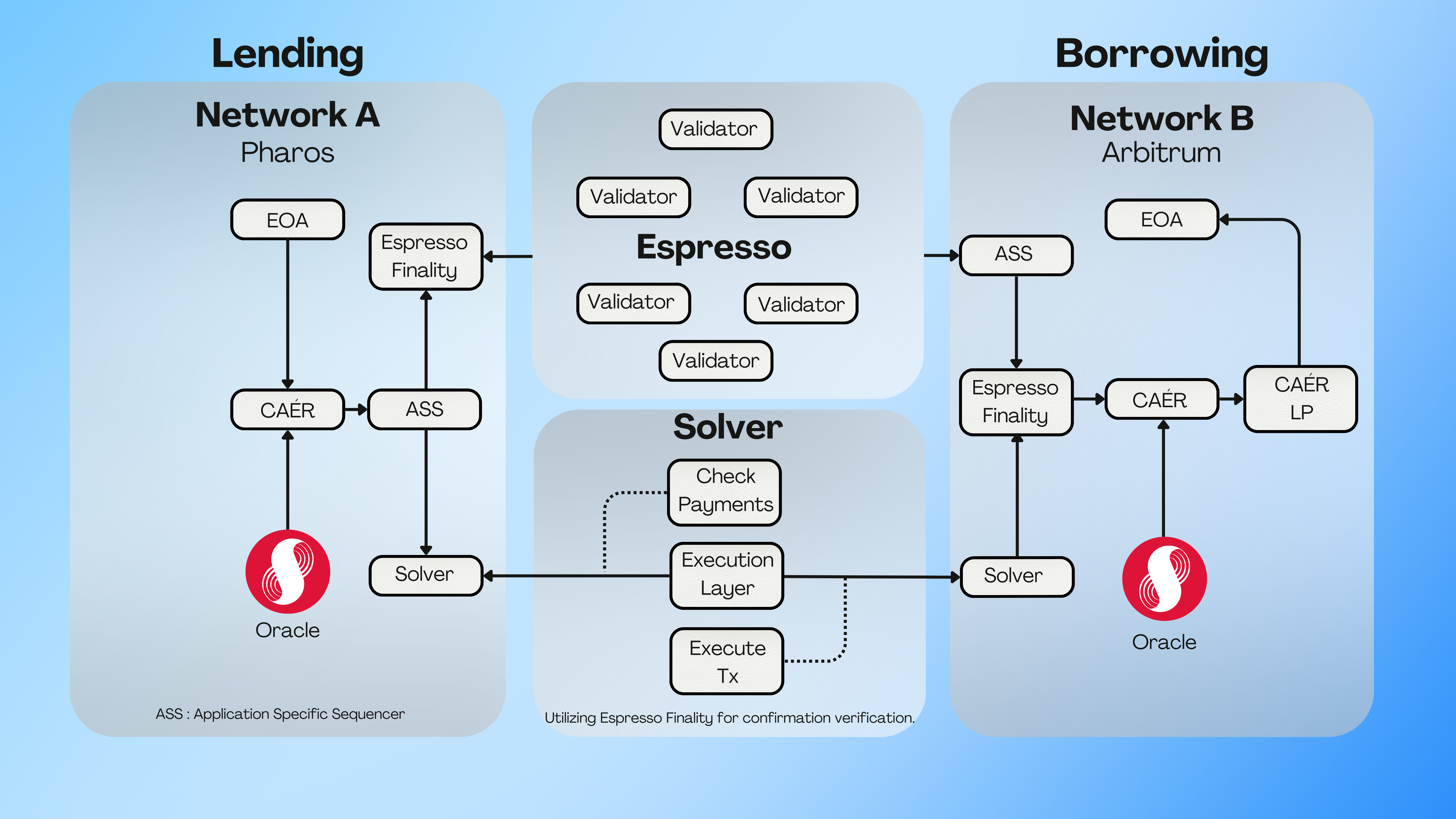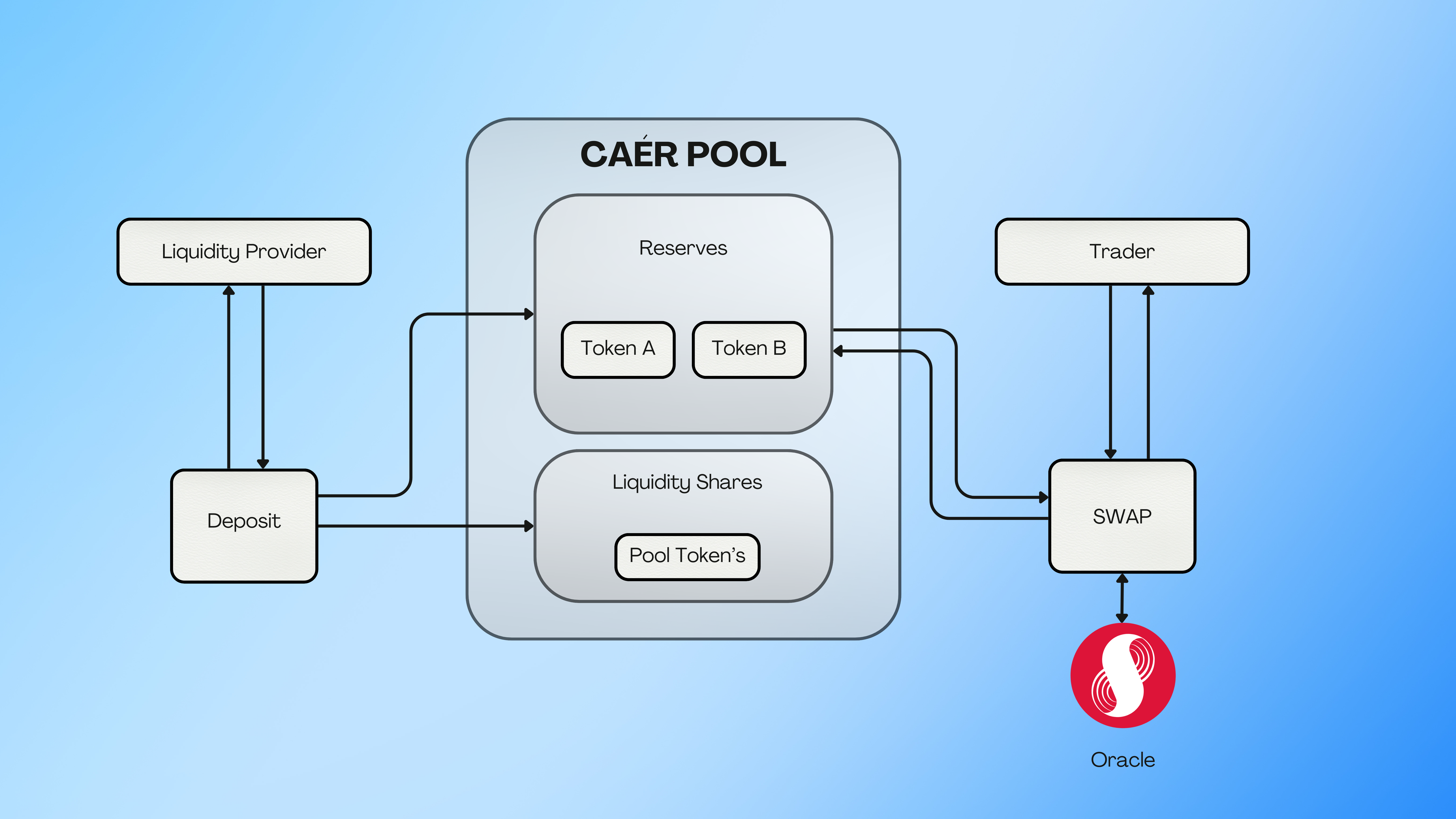Caér Finance is a cross-chain lending protocol on Pharos, supporting RWA and using ASS and Espresso for secure, seamless interoperability. It's modular, efficient, and built to power DeFi growth.
Caér Finance is a next-generation cross-chain lending and borrowing protocol designed as a core DeFi primitive within the Pharos ecosystem. It enables seamless supply, borrowing, and collateral management of assets—including Real World Assets (RWA)—across multiple blockchain networks via a unified, decentralized platform. By supporting tokenized RWA such as gold, tokenized stocks, and other real-world assets to come, Caér bridges traditional finance with on-chain liquidity, unlocking new capital markets and improving access to credit globally.
At the protocol layer, Caér is powered by an Application-Specific Sequencer (ASS) that ensures secure, deterministic transaction ordering and execution across chains. This sequencer maintains trustless interoperability while enabling high-throughput and low-latency cross-chain operations.
For finality and security, Caér integrates with Espresso, a decentralized finality layer, providing fast and verifiable settlement without relying on centralized bridges or custodians. This architecture preserves decentralization and composability while ensuring the integrity of cross-chain RWA transactions.
To further enhance data accuracy, transparency, and risk management, Caér integrates Supra Oracle, a high-performance decentralized oracle network. Supra delivers reliable real-time price feeds and off-chain data—crucial for evaluating collateral value, determining liquidation thresholds, and maintaining accurate interest rate models. This ensures that all loan positions within Caér are backed by timely and tamper-resistant data, especially for volatile or real-world assets.
By combining protocol-level sequencing, robust cross-chain finality, advanced oracle data from Supra, and native RWA support, Caér Finance delivers a modular, scalable, and institutional-grade lending infrastructure—positioning Pharos as a leading hub for real-world DeFi innovation.
Caér uses an Application-Specific Sequencer (ASS) to verify data from the main or other chains, ensuring secure and efficient cross-chain lending. Unlike general-purpose sequencers, it is tailored to handle collateral verification, transaction processing, and seamless execution. By integrating Espresso’s finality, the sequencer guarantees instant confirmation and prevents unauthorized transactions. This approach enhances security, reduces delays, and optimizes cross-chain liquidity, making Caér’s lending model faster and more reliable.

This diagram illustrates the cross-chain lending and borrowing mechanism in Caér, powered by the Pharos and Arbitrum networks. The system ensures trustless execution, fast finality, and secure interoperability using Application-Specific Sequencer (ASS), Espresso Finality, Solvers, and Supra Oracle.
Below is an overview of our cross-chain lending mechanism:
The user deposits 1 PAXG (tokenized gold) as collateral on Chain A (Pharos).
The user initiates a request to borrow 100 USDC on Chain B (Arbitrum).
Before processing the loan, Supra Oracle provides the real-time USD value of 1 PAXG, ensuring that the collateral meets the required Loan-to-Value (LTV) ratio.
ASS verifies the deposit on Chain A and uses the price data from Supra to confirm the user's collateral is sufficient. The ASS cross-checks the deposit and price status before approving the loan request.
The sequencer leverages Espresso confirmations to ensure transaction finality within sub-15 seconds. Once confirmed, ASS generates a signature, verifying that the deposit exists, the price is valid, and the loan request is approved.
The generated ASS signature is embedded into the transaction, enabling secure execution on Chain B.
The solver, upon receiving the verified ASS signature, releases 100 USDC to the user's address on Chain B. By integrating ASS, Supra, and Espresso, Caér ensures trustless execution, accurate collateral valuation, and fast cross-chain finality—making lending and borrowing secure, scalable, and RWA-friendly.
Note: For the purposes of this hackathon, we are using mock tokens to simulate transactions and interactions within the platform. Additionally, the platform is operating on a testnet environment.

Caér implements a decentralized swap mechanism inspired by Automated Market Maker (AMM) models, enabling seamless token exchanges within the Caér Pool. The workflow below describes the process of token swapping and liquidity provision on the platform. But how does Caér’s swap system enhance the lending and borrowing experience? Unlike traditional swaps, Caér’s decentralized swap mechanism is designed specifically to trade collateral assets. This means users must hold an active lending or borrowing position to access swap functionalities, ensuring capital efficiency and seamless liquidity management.
Liquidity Providers (LPs) deposit pairs of tokens (e.g., Token A and Token B) into the Caér Pool. In return, LPs receive Pool Tokens, which represent their share of the liquidity pool and entitle them to a proportion of the transaction fees generated from swaps.
The Caér Pool maintains reserves of the deposited tokens and continuously updates balances as users perform swap operations. Reserves are used to facilitate trades between Token A and Token B without relying on external order books.
Traders initiate swaps through the Caér Swap interface by selecting the tokens they wish to exchange—such as swapping Token A for Token B. But here’s what makes Caér unique: To access swap functionalities, users must hold an active lending or borrowing position. This ensures that swaps are directly integrated with the lending and borrowing protocol, providing capital efficiency and enhanced liquidity management. The swap functionality applies an Automated Market Maker (AMM) formula to determine the exchange rate, considering the current reserves of the involved tokens. Upon successful execution, the Caér Pool updates the reserves accordingly.
A small fee is applied to each swap, distributed to Liquidity Providers based on their share of the pool. These fees incentivize LPs to maintain liquidity within the pool, enhancing platform efficiency and accessibility.
LPs can withdraw their liquidity at any time by redeeming their Pool Tokens. Upon withdrawal, the provider receives their proportional share of the pool’s reserves along with any accumulated fees.
Caér integrates Supra Oracle to provide accurate, real-time price feeds for the tokens involved in swaps. These oracle feeds ensure the AMM pricing logic aligns with external market rates, preventing price manipulation and ensuring fair value exchanges—especially important for collateral asset swaps. During each swap, Supra Oracle verifies the current market value of Token A and Token B, enhancing the security and reliability of the platform.
Presentation: Caér Finance Presentation
Repository: Caér Finance Github Repository
Documentation: Caér Finance Documentation
Website: Caér Finance Website
Demo Video: Caér Finance Demo Video
Pitch Video: Caér Finance Pitch Video
Get Faucets: Caér Finance Faucets
100%
Top 12 Finalist Build & Brew Espresso Global Hackathon